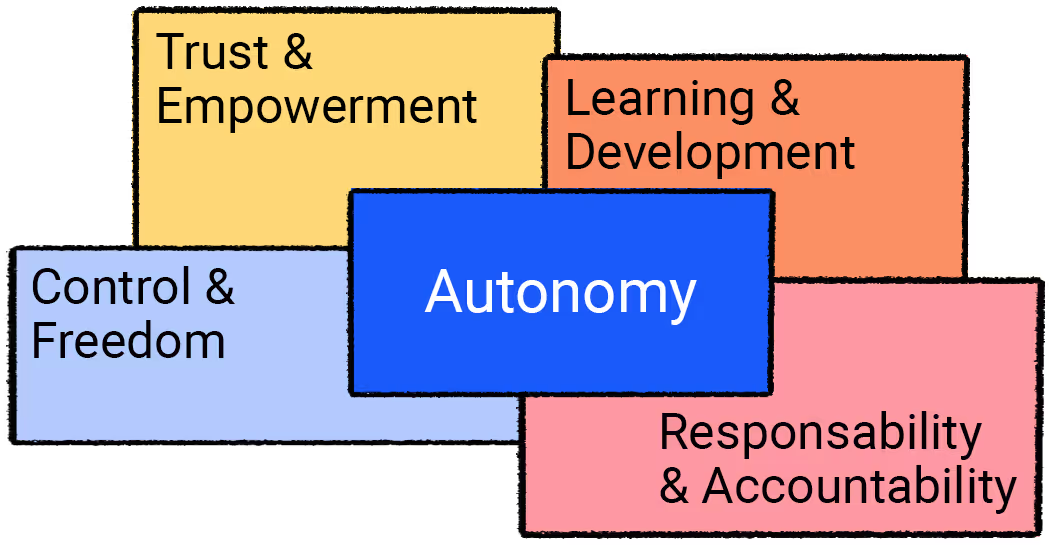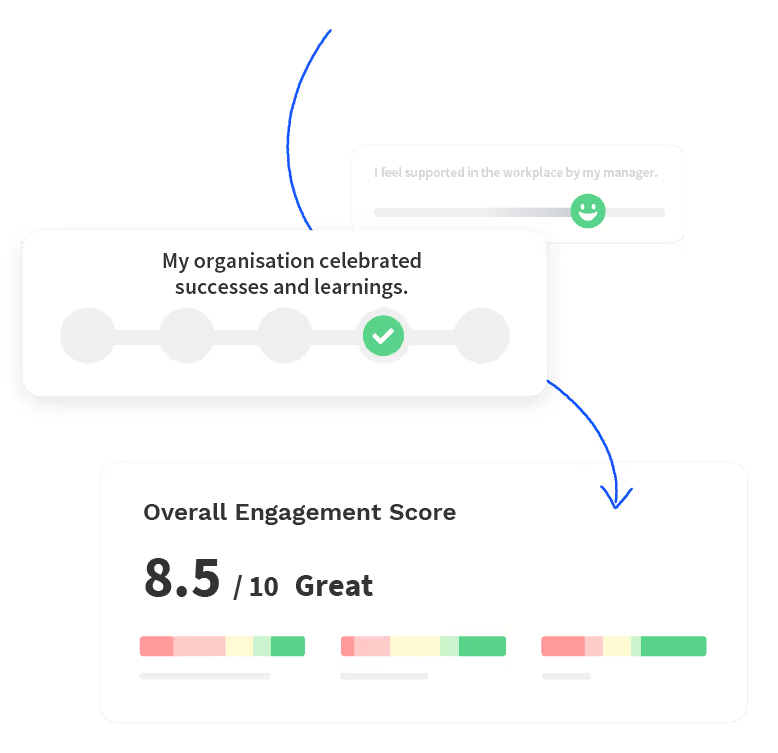7 tips to master employee autonomy in the remote workplace

%20(1).png)
In times of change and with a newly dispersed workforce, we see new challenges for managers around employee autonomy in the workplace. In fact, since we’ve made the shift to remote work, our employee feedback data has seen the term “micromanager” — What Gallup refers to as the “boogeyman” of the business world — pop up often.
With a remote team, you may perceive having lost some visibility and control. At this point, you might feel more inclined to grab the steering wheel and make the mistake of hovering. We’re here to help you keep the ‘micro’ at bay so you can focus on being the manager your team needs.
What is employee autonomy?
Employee Autonomy is "the extent to which employees have control and discretion for how to conduct their tasks." It refers to our desire as people and workers to be self-directed, and have a sense of agency over ourselves, our work, and our environment.
In his book Drive, author Dan Pink introduced autonomy as part of the trifecta of factors that most motivate workers:
- Mastery (mastering our skills)
- Purpose (finding meaning in our work)
- Autonomy (having a sense of agency over it all)
Let's take a look at how that can transpire in the workplace.

When managers using Officevibe asked their employees: Do you feel you have enough freedom to decide how you do your work? We see that only 18% do not feel they have enough freedom. This is mostly positive. And when we dig deeper into our feedback to understand why we see a strong connection to flexibility (when and where they work) and the essential ingredient of trust from their managers and peers. This refers to trust in their expertise, skills, and decision-making.

When managers asked their employees whether they feel appropriately involved in decisions that affect their work, unfortunately, 32% of employees do not! So while we see that managers are succeeding in letting employees decide how to do their work, there is work to be done to ensure that employees are involved in important discussions and decisions that affect their work.

When managers asked their teams if they feel they are in control regarding the work they need to accomplish, 20% admitted that they do not. Having an overall sense of agency over one’s day-to-day work is essential for employees to remain engaged. Managers need to look out for this stat because micromanaged employees can quickly fall on the dark path of becoming disengaged employees.

Overall, 50% of employees strongly agree that they are satisfied with the level of autonomy they have at work. The glass is half full, but we still have some pouring to do.
These and more Officevibe insights help managers balance 'too much guidance' with being 'too laissez-faire’ and encourage employees to regularly think about their levels of autonomy, to question what's right for them, and to know that at the other end, there is a caring manager who is there when needed.
💡 You can ask these same questions to your team with Officevibe's employment engagement software.
As a visual, employee autonomy would look something like this:

For managers, it’s more than just giving people the freedom to make decisions their own way, but to avoid micro-monitoring them as they do it. Truly granting employees autonomy at work means entrusting them with responsibility, empowering them with accountability, and keeping them involved in the decision-making processes that affect their work.
Why is employee autonomy so important for engaging modern workers?
Modern employees hold the opportunity for growth and learning at an unprecedented standard. People want to become the best versions of themselves, and companies that let them do this are companies that attract the best talent. The end goal of employee autonomy at work is for each team member to have the opportunity to learn and develop in their role, adding to their success and the success of the team at large.
When is it ok for managers to give more direction?

- Onboarding new employees
- Assigning new responsibilities
- When the task is more complex than usual
- When a performance plan is needed
- An employee requests or prefers more feedback
What are the effects of employee autonomy?
More autonomy correlates to greater job satisfaction. The more control we have, the more motivated we become to succeed. When employees feel their managers trust them with this control, they are confident, loyal and performing.
✅ Employee Autonomy DOS
- Guide employees at the necessary touchpoints
- Trust their skills and capabilities
- Communicate clear goals and “what” needs to be done
- Coach employees to come to their own discoveries by asking the right questions
- Trust their decisions for sick days, time off, personal days and work hours
- Let employees test and apply learnings
❌ Employee Autonomy DO NOTS
- Be a bottleneck by needing to approve everything
- Track their obedience
- Tell them the “how” to do it
- Let them know the way you want it done
- Question what is best for them or control their choices
- Focus on mistakes

4 managers share their thoughts on employee autonomy during remote work
Most modern managers recognize the value of encouraging high employee autonomy in workplace culture. Many, however, were not prepared to test that mindset so radically, and on such short notice. Here's what four managers have to say:
Mikhail is a BI manager of a team for a small aerospace engineering consultancy firm
"I think the team feels a great sense of autonomy for their work now that they are working remotely," he says. "There is no sense of someone looking over their shoulder. Team members have expressed that because of this trust, they actually feel more productive.”
GR leads a team of 12 managers, as the CEO of his company
“With increased autonomy at work, it required that our leadership team take the time to clarify objectives and expectations in a much more explicit way to ensure they are clear and comprehended by everyone. This gave us the push to improve all our strategic documentation and communications. We didn't want to pull back the reigns on autonomy, so we ensured that everyone was set up with the right information and tools to work their best.”
{highlight}
GR's best tip: Don’t be afraid to over-communicate the vision, strategy and objectives with documents, team meetings and 1-on-1 conversations. Then, clarify any grey areas that come up within teams regarding responsibilities and expectations, so everyone knows exactly what is expected of them.
{highlight}
Lin is an analytics manager with a team of 8 at a large clothing distribution company
Lin initially worried about "disruptions related to family obligations interfering with work," but in the end, she found that by trusting her team and allowing "flexible working hours […] the team pushes hard when it's required but also takes it easier if the situation allows it." She was also concerned about the level of autonomy to give new employees during onboarding, but solved that by intentionally setting “more frequent feedback cycles”.
Charles is a first-time manager on a sales team of 5 employees
In order to perform during this remote work reality, my team needs autonomy, but without the right data, I would fall into the same trap I used to fall into when I was a team leader; micromanagement! In order to have the right discussions at the right time, I use the team & individual goal-setting tool in Officevibe to make sure everyone’s on track, without checking in on them too often.
Benefits and challenges of employee autonomy in a remote-work setting:
Not everyone will react the same to the great shift to work from home. Understanding that change comes with pros and cons for everyone is key to leading each individual employee successfully.
Benefits
- Working from home gives employees the practical autonomy of being flexible with how and where they work. It also saves them time otherwise spent on commuting and allows people to choose the hours that are most productive for them.
- People have more control over their workspace environment. Who knows which employee might find more focus curled up with a laptop on their sofa or indulging in the autonomy of a self-created space without the distraction of office chatter.
- Giving your team more remote autonomy shows you trust them. This makes them trust you, and themselves, in return. Employees who trust their managers are always ready to go the extra mile because they know their efforts are recognized and rewarded.
Challenges
- Less daily structure can be overwhelming for employees. It can be intimidating to advance a project without being sure of manager feedback. Be sure to ask your employees how often they’d like to check in, and even encourage them to book recurring meetings with you at the frequency that is most comfortable for them.
- A huge management challenge is the temptation to micromanage. Are you worried your employees will work less? Will they multitask too much? Have they been sufficiently guided towards their goals? It's normal to feel anxious over these questions. You will have less visibility over their individual processes and their day-to-day progress. The first step to finding that right micro-to-autonomous managing balance is to trust your team.
- Your employees are people who want the autonomy to experiment and grow, but sometimes this doesn't always work out. With increased autonomy, there is always the chance a mistake can go unnoticed for longer than normal, and from there, projects can get increasingly derailed.

7 tips to master employee autonomy
1. You hired them for a job, trust them to do it
In one way or another, all of our general advice and actionable insights revolve around trust. Whether it's keeping your virtual door open to talk, engaging your team in shared goal setting, or giving them the space to try new solutions on their own: you need to demonstrate you trust your team now more than ever. You hired them to fulfill a job, so let them show you that they can do it.
2. Talk about autonomy needs with each employee
You're likely going to have a lot of video group meetings, but don't forget regular 1-on-1 meetings. Don't just talk about their jobs and upcoming tasks. Use personal meetings to determine with each individual just how much autonomy is right for them. And find out what they expect from you as a leader to encourage them to work confidently on their own.
3. Set effective goals then step away until needed
Employee autonomy is about properly setting goals, clarifying expectations, and agreeing on deliverables, then giving them the freedom to reach those goals in their own way. But don't dictate goals on your own. Set them together with your employees then sit back and let them know your virtual door is always open.
4. Promote colleagues as a gut-check resource
There are great advantages to encouraging some horizontal help. Create a "buddy" system where employees can ask for help and discuss or test out ideas on each other before coming to management. It demonstrates trust and promotes autonomy at work while boosting team cohesion. It's also a great resource for new hires, especially when they won't have the in-office onboarding experience.
5. Set autonomy norms with your team
This is a neat tactic we've uncovered from some seasoned remote managers. It's like an informal contract or set of norms you create with your team, or with individual employees, outlining a set of guidelines as to what autonomy at work means for everyone. It can include how often or how detailed project updates should be, or whether updates are done verbally or as written reports. It can define what kind of problems should be handled independently, and which should be brought to management's attention.
6. Question your intent before micromanaging
Whenever you feel the need to reach out and check up on someone's progress, first ask yourself, "why?" The answer may not be as obvious as it at first seemed. Do you really need the information at this point, or is it a nervous micromanager reflex? Are you sure you don’t have enough visibility, or is it just a need to control? If you give yourself that moment's reflection, you'll realize you might have missed an opportunity to empower your employee with trust and autonomy.
7. Set them up with the right feedback tools to share their concerns
With work-from-home setups, you can leverage amazing apps that allow employees to give feedback on how they are feeling about the level of control they feel they have over their own work, or whether they feel you’re over-managing. One of these tools is Officevibe.
Officevibe: the perfect tool to understand and engage your team
Officevibe's Pulse Survey tool lets employees give anonymous feedback to their managers about various aspects of their job satisfaction and morale, such as their level of autonomy.
How will Officevibe help you as a manager?

- You’ll get weekly employee insights so you can see exactly where things are going well, and where things need improvement.
- You’ll get real, honest feedback from employees on everything from how they’re feeling about their levels of autonomy to how they feel about their relationship with you as their manager.
- You’ll get expert guidance responding to this feedback, and guidance to have better 1-on-1 conversations.
- Lastly, we build an entire curated library for you with the best tools, articles and insights into how to tackle all of your management challenges.
Sign up for Officevibe and lead the team everyone wants to be on.
Give HR and managers the clarity, confidence, and connection to lead better every day.


%20(1).avif)


.avif)
.avif)








